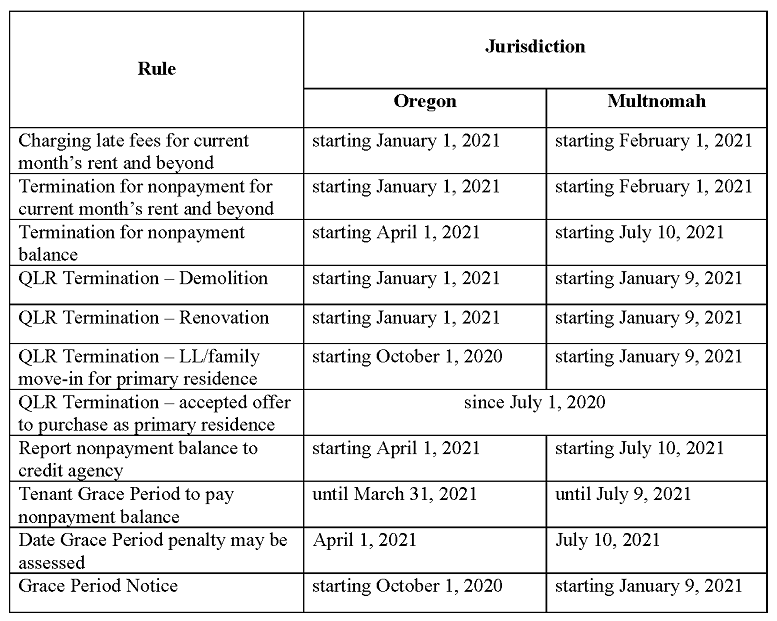Changes to Eviction Moratoria in Oregon
In Oregon, HB 4213’s “Emergency Period” was set to expire on September 30, 2020. As anticipated, the rules in HB 4213 relating to Residential tenancies were changed last minute in Multnomah County by Ordinance 1287 and statewide by Governor Brown’s Executive Order 20-56 (“EO 20-56”). Both extend the protections in HB 4213 but vary in small but important ways.
This article addresses the new restrictions and how they vary between Multnomah County and the rest of Oregon. You should familiarize yourself with these changes immediately and adjust any policies or procedures accordingly. A review of HB 4213 is linked here as its requirements are still applicable despite being modified as described here.
The applicable changes are as follows:
1. Prohibited Conduct
The chart below provides a quick comparison of rules in Oregon and Multnomah County and the dates affecting certain actions.

Oregon
EO 20-56 extends the eviction moratorium by extending HB 4213’s restrictions on termination of tenancy based on termination notices “without cause” (meaning termination of month-to-month tenancies, non-renewals without stated cause and Qualifying Landlord Reasons (“QLR”) for intent to demolish or renovate) and for termination of tenancy for “nonpayment” until December 31, 2020. However, Landlords outside Multnomah County who intend to move in or to move in an immediate family member as a primary residence may now issue corresponding QLR termination notices in Oregon.
Multnomah County
Multnomah County’s Ordinance has all the same protections listed above but varies slightly, defining “nonpayment” to apply to missed payments between October 1, 2020 and January 8, 2021, effectively extending the protections above by eight (8) days.
In addition, the Multnomah County protections apply to taking action related to the “nonpayment balance”, which is more inclusive than HB 4213 and EO 20-56 as it defines nonpayment to include:
“all or a part of the net total amount of all items of nonpayment by a tenant, and all unpaid amounts that accrued by operation of ORS 90.220(9) during the six-month Grace Period described in subsection (G) of this section, provided that the tenant makes payment in an amount equal to or greater than the rent for the current rental period.”
The underlined provision above was added to HB 4213’s definition and its implications are not entirely clear. If a Tenant fails to pay rent in February 2021 or beyond, a termination for nonpayment may be issued. However, if a Tenant pays at least the amount of the current month’s rent, the ability to terminate for any other amounts may be impacted. We recommend that you seek legal counsel in such circumstances before issuing any nonpayment notices, pushing an eviction case forward, or threatening to either of the two.
In addition, unlike EO 20-56, Multnomah County’s definition of “termination without stated cause” retained the prohibition on issuing a qualifying landlord-reason for intent of Landlord or Landlord’s immediate family to use the rental as a primary residence. Consequently, that option is not available until January 9, 2021 at the earliest.
2. Emergency Period Notice
M176 OR Emergency COVID-19 Balance Reminder Notice
Oregon
For Oregon, the Emergency Period balance reminder notice must also include a statement that eviction for nonpayment is not allowed before December 31, 2020.
Multnomah County
In Multnomah County, the Emergency Period balance reminder notice must also include a statement that eviction for nonpayment is not allowed before the end of the Emergency Period which is defined as the period from October 1, 2020 to January 8, 2021, or the first day the emergency declared in Multnomah County Executive Rule 388 and its addendum, as extended by the County Board, is no longer in effect, whichever is later.
3. Grace Period Notices
M177 OR HB 4213 Emergency COVID-19 Grace Period Notice
M178 OR Emergency COVID-19 Grace Period Voluntary Alternate Payment Plan)
Grace Period notices under HB 4213, if given, allow housing providers to assess a half month’s rent penalty after the Grace Period if the Tenant fails to timely pay in full or notify the Landlord that they intend to use the Grace Period. Again, Governor Brown’s EO 20-56 made a minor modification to this while Multnomah County’s took a very different approach.
Oregon
The Grace Period notices permitted by HB 4213 may still be issued on or after October 1, 2020 so long as they state that eviction is not allowed before December 31, 2020. As a reminder, Tenants have until March 31, 2021 to pay off the debts accrued between April 1, 2020 and September 30, 2020.
Multnomah County
Multnomah County’s Grace Period notice appears to cover an entirely different nonpayment period, namely any debts accrued between October 1, 2020 and January 8, 2021 (unless extended), effectively allowing Multnomah County Tenants to have a Grace Period to repay amounts owed from April 1, 2020 until January 8, 2021.
The Grace Period notice requirements mirror those in HB 4213, except that the notice may not be issued until the Multnomah Grace Period begins (currently set for January 9, 2021), and the date listed in the notice must state when the Multnomah Grace Period ended.
Although the serving of Grace Period notice as set forth in HB 4213 is not strictly prohibited in the Multnomah County Ordinance, these notices must be carefully drafted so as to take into account the specific Ordinance requirements. As such, use of forms approved by an attorney is strongly advised.
Please be advised that the language in the Multnomah County Ordinance is in places vague, and subject to interpretation. Multnomah County Landlords wishing to send notices to their Residents about balances due from April 1, 2020 onward at any time before January 9, 2021 should consult with counsel about all risks prior to proceeding.
This letter is not intended as legal advice. Please obtain advice of an attorney for any policy change or decisions regarding Residential and commercial Landlord-Tenant matters, as well as laws that impact your local jurisdictions.
